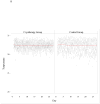Impact of daily cooling treatment on skin inflammation in patients with chronic venous disease
- PMID: 25703058
- PMCID: PMC4449798
- DOI: 10.1016/j.jtv.2015.01.006
Impact of daily cooling treatment on skin inflammation in patients with chronic venous disease
Abstract
People with chronic venous disease are at high risk for developing venous leg ulcers. Inflammation is posited as a pathological factor for this chronic condition as evidenced by persistently elevated skin temperature. As part of a larger trial to test the effects of a cooling regimen on leg ulcer prevention, the objective of this preliminary study was to evaluate the first 30 days of intense daily cooling. Compared to a placebo control cuff, a gel cuff applied to the most severely affected lower leg skin for 30 min daily showed no statistically significant differences between temperatures taken in the home at baseline compared to those measured at the 1 month follow up visit. There were also no differences in temperatures noted between the two groups, although the temperatures in the treatment group were lower 30 min after treatment, an indication of adherence. There was no discernable decrease or increase in temperature at a given time point during the 30 day treatment period compared to the control group. It may be better to have patients monitor skin temperature on a daily basis and then apply the cuff as necessary, rather than requiring daily cooling based on baseline measurement. This "prn" approach may provide a sufficient cooling milieu to prevent escalation of inflammation and thwart ulcer occurrence or recurrence. Clinical trials registration #NCT01509599.
Keywords: Chronic venous disease; Inflammation; Local cooling; Skin temperature.
Copyright © 2015 Tissue Viability Society. Published by Elsevier Ltd. All rights reserved.
Conflict of interest statement
Figures






Similar articles
-
The effect of a cryotherapy gel wrap on the microcirculation of skin affected by chronic venous disorders.J Adv Nurs. 2011 Nov;67(11):2337-49. doi: 10.1111/j.1365-2648.2011.05680.x. Epub 2011 May 19. J Adv Nurs. 2011. PMID: 21592186 Free PMC article. Clinical Trial.
-
Effectiveness of cooling therapy (cryotherapy) on leg pain and self-efficacy in patients with chronic venous disease: A randomized controlled trial.Int J Nurs Stud. 2018 Oct;86:1-10. doi: 10.1016/j.ijnurstu.2018.04.015. Epub 2018 Apr 26. Int J Nurs Stud. 2018. PMID: 29957362 Free PMC article. Clinical Trial.
-
Symptoms Associated With Chronic Venous Disease in Response to a Cooling Treatment Compared to Placebo: A Randomized Clinical Trial.J Wound Ostomy Continence Nurs. 2018 Jul/Aug;45(4):301-309. doi: 10.1097/WON.0000000000000441. J Wound Ostomy Continence Nurs. 2018. PMID: 29846278 Free PMC article. Clinical Trial.
-
Microcirculatory dysfunction in chronic venous insufficiency (CVI).Microcirculation. 2000;7(6 Pt 2):S3-12. Microcirculation. 2000. PMID: 11151969 Review.
-
[Update on current care guidelines: chronic leg ulcers].Duodecim. 2014;130(9):942-3. Duodecim. 2014. PMID: 24881146 Review. Finnish.
Cited by
-
Research on a physical activity tracking system based upon three-axis accelerometer for patients with leg ulcers.Healthc Technol Lett. 2019 Aug 21;6(5):147-152. doi: 10.1049/htl.2019.0008. eCollection 2019 Oct. Healthc Technol Lett. 2019. PMID: 31839971 Free PMC article.
References
-
- Neglen P, Eklof B, Kulwicki A, Davies A, Deschamps T, et al. Writing Group IIotPVS. Prevention and treatment of venous ulcers in primary chronic venous insufficiency. J Vasc Surg. 2010;52:15S–20S. - PubMed
-
- Simka M. Cellular and molecular mechanisms of venous leg ulcers development--the “puzzle” theory. Int Angiol. 2010;29:1–19. - PubMed
-
- Smith PC. The causes of skin damage and leg ulceration in chronic venous disease. Int J Low Extrem Wounds. 2006;5:160–8. - PubMed
-
- Raffetto JD. Dermal pathology, cellular biology, and inflammation in chronic venous disease. Thromb Res. 2009;123(Suppl 4):S66–71. - PubMed
Publication types
MeSH terms
Associated data
Grants and funding
LinkOut - more resources
Full Text Sources
Other Literature Sources
Medical
Research Materials

